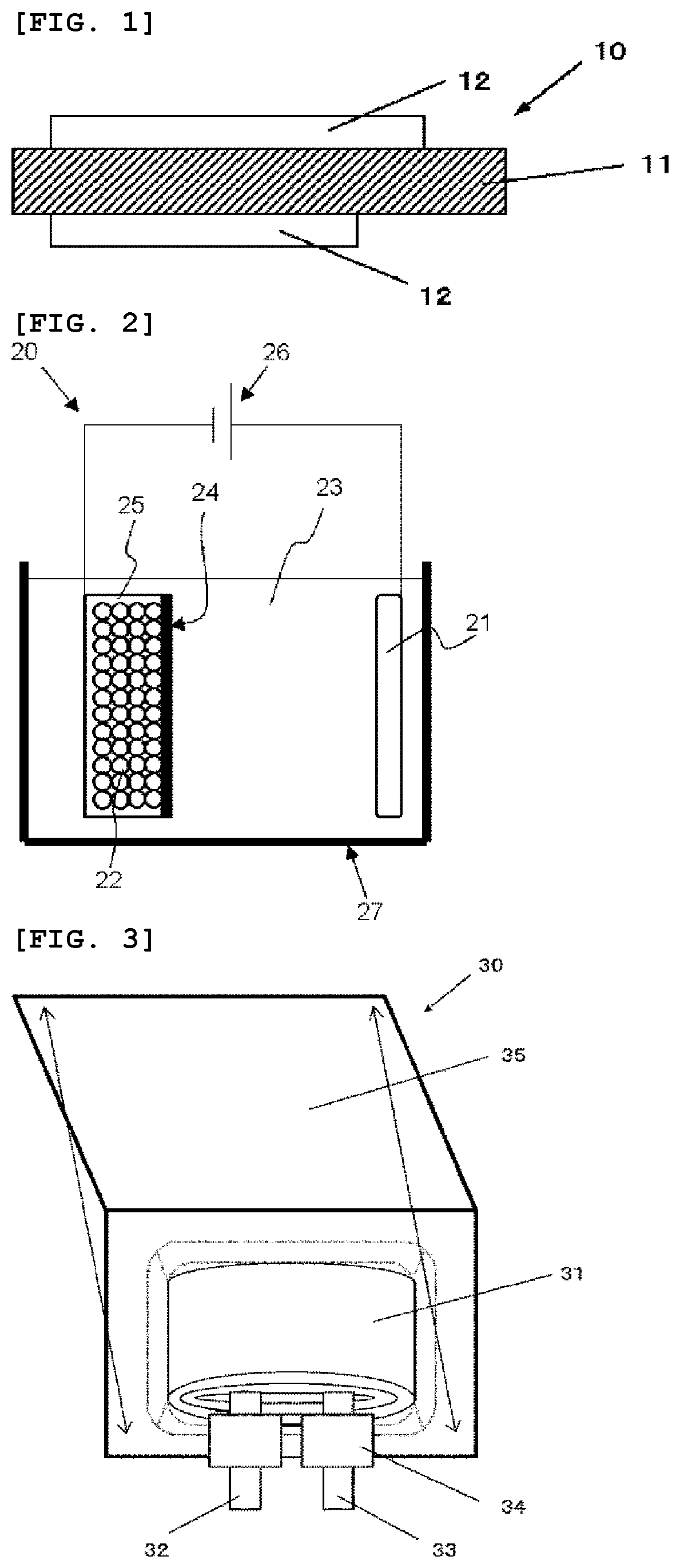Negative electrode active material for non-aqueous electrolyte secondary battery, non-aqueous electrolyte secondary battery, and method for producing negative electrode material for non-aqueous electrolyte secondary battery
a secondary battery and active material technology, applied in the direction of cell components, electrochemical generators, silicates, etc., can solve the problems of electrolyte consumption, achieve favorable battery capacity, cycle characteristics, and first time charge-discharge characteristics, and improve the stability of a slurry fabricated
- Summary
- Abstract
- Description
- Claims
- Application Information
AI Technical Summary
Benefits of technology
Problems solved by technology
Method used
Image
Examples
example 1-1
[0143]The laminate film type secondary battery 30 shown in FIG. 3 was produced by the following procedure.
[0144]The procedure began with the production of a positive electrode. A positive-electrode mixture was prepared by mixing 95 parts by mass of lithium-nickel-cobalt-aluminum complex oxide (LiNi0.7Co0.25Al0.05O) as a positive electrode active material, 2.5 parts by mass of a positive electrode conductive assistant agent (acetylene black), and 2.5 parts by mass of a positive electrode binder (polyvinylidene fluoride: PVDF). Then, the positive-electrode mixture was dispersed in an organic solvent (N-methyl-2-pyrrolidone, NMP) to form a paste slurry. The slurry was subsequently applied to both surfaces of a positive electrode current collector with a coating apparatus having a die head and dried with a drying apparatus of hot-air type. The positive electrode current collector used here had a thickness of 15 μm. The resultant was finally compressed with a roll press.
[0145]Next, a neg...
examples 1-2 to 1-5
, Comparative Examples 1-2, 1-3
[0164]With a silicon compound shown by SiOx, the evaluation of the cycle characteristics of the secondary battery and the other evaluations were performed by the same procedures as in Example 1-1 except that the value of x was changed.
[0165]
TABLE 2SiOx D50 = 5 μm, graphite (natural graphite:artificialgraphite = 5:5) D50 = 20 μm SiOx ratio: 10 mass %,Li2Si2O5, coating amount of carbon: 5 mass %, A / B =4.8 half value width: 1.85°, crystallite size: 4.6 nm,modification method: oxidation-reduction method,volume resistivity: 0.3 ΩcmInitialCapacityefficiencyretentionx%rate %Comparative0.391.2%72%Example 1-2Example 1-1189.5%82%Example 1-20.590.5%81%Example 1-30.790.1%82%Example 1-41.289.1%82%Example 1-51.689.1%83%Comparative1.8——Example 1-3
[0166]As shown in Table 2, with a silicon compound shown by SiOx, when the value of x was outside the range of 0.5≤x≤1.6, the battery characteristics were degraded. For example, as shown in Comparative Example 1-2, when ther...
examples 2-1 to 2-3
, Comparative Example 2-1
[0167]In Examples 2-1 to 2-3, a negative electrode active material, a negative electrode material, and a secondary battery were fabricated and the evaluation of the cycle characteristics of the secondary battery and the other evaluations were performed by the same procedures as in Example 1-1 except that the Li silicate type was changed by changing the Li doping amount. In Comparative Example 2-1, Li doping was not performed, but the other procedures including the cleaning were performed as in Example 1-1, and a negative electrode active material, a negative electrode material, and a secondary battery were fabricated, and the evaluation of the cycle characteristics of the secondary battery and the other evaluations were performed.
[0168]
TABLE 3SiOx: x = 1 D50 = 5 μm, graphite (natural graphite:artificialgraphite = 5:5) D50 = 20 μm SiOx ratio: 10mass %, coating amount of carbon: 5 mass %, A / B = 4.8half value width: 1.85°, crystallite size: 4.6 nm, modification...
PUM
| Property | Measurement | Unit |
|---|---|---|
| volume resistivity | aaaaa | aaaaa |
| volume resistivity | aaaaa | aaaaa |
| crystallite size | aaaaa | aaaaa |
Abstract
Description
Claims
Application Information
 Login to View More
Login to View More - R&D
- Intellectual Property
- Life Sciences
- Materials
- Tech Scout
- Unparalleled Data Quality
- Higher Quality Content
- 60% Fewer Hallucinations
Browse by: Latest US Patents, China's latest patents, Technical Efficacy Thesaurus, Application Domain, Technology Topic, Popular Technical Reports.
© 2025 PatSnap. All rights reserved.Legal|Privacy policy|Modern Slavery Act Transparency Statement|Sitemap|About US| Contact US: help@patsnap.com

